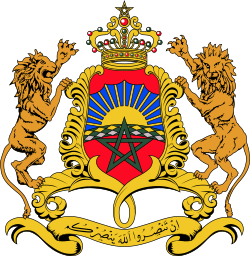| Coat of arms of Morocco | |
|---|---|
 | |
| Versions | |
 | |
| Armiger | Mohammed VI, King of Morocco |
| Adopted | 1957 |
| Crest | Or, the Royal Crown of Morocco, embellished with pearls alternately Gules and Vert |
| Shield | Gules, in chief a demi-sun setting, with 15 rays or on a background azure, supported by a fess in bar enarched vert, fusily or and argent; the whole surcharged by an interlaced pentalpha vert on a background gules. |
| Supporters | Two Atlas lions proper, the one in dexter in profile and in sinister affronté |
| Motto | Arabic: إِنْ تَنْصُرُوا اللهَ يَنْصُرُكُمْ (ʾIn tanṣurūw Allāha yanṣurukum, "If you glorify God, He will glorify you") |
The coat of arms of Morocco is the arms of dominion of the King of Morocco. It was introduced on 14 August 1957.




